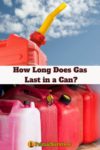There’s little point in having a getaway car primed and ready to go if you don’t have any fuel to put in it.
In an ideal world, we’d all be running our vehicles off solar power, but that’s not yet the case. Instead, we’re dependent on perishable fuels like gasoline.
How Long Does Gas Last in a Can?
Standard E10 Gasoline sold on most forecourts in the US will last approximately three months in a can. The ethanol content means that fuel evaporates and oxidizes faster than pure gasoline. Non-ethanol gasoline is a better option for long-term storage and can last up to six months if stored correctly.
How Long Does Gas Last in a Car?
Gasoline lasts no longer in your vehicle’s fuel tank than it does in a can. In E10 fuel, the ethanol will lose its combustibility within three months, regardless of where it’s stored.
Non-ethanol gasoline also maintains the same life expectancy when stored in a fuel tank as it has in a can.
How Ethanol Affects Gas Storage
Ethanol is hydrophilic, which means that, like a duck, it’s attracted to water and will readily absorb any moisture or condensation. This water content contaminates the fuel and corrodes your vehicle’s fuel system.
If left for long enough, the ethanol attaches itself to the water molecules, causing phase separation. During this process, the gasoline forms a distinct top layer, while the ethanol-water mixture sinks to the bottom.
Therefore, the higher the ethanol content, the shorter the gasoline’s shelf life. Even storing it in a high-quality gas can, does little to extend its lifespan.
Bearing in mind that your gasoline may already be over a month old by the time you pump it into your storage can, it doesn’t give you much leeway.
How To Tell If Your Gas Has Gone Bad
If your “check engine” light comes on when your car is running and has sufficient oil, the problem’s most probably associated with gasoline that’s no longer burning correctly.
Gasoline that’s gone bad will also develop a darker, almost muddy, appearance accompanied by a sour odor that’s easily distinguishable from the typical fuel smell.
Not only does contaminated gasoline cause operational problems, but it can also damage the engine. It may block the fuel line with a sticky residue or draw water vapor into the tank, corroding the fuel system.
To double-check if your gasoline is still usable, take a small sample and compare it to freshly pumped gas of the same variety.
Put each sample into a glass jar and place them side by side for comparison. If the used gas is slightly darker than the fresh gas, it’s old but not contaminated. If, however, you can see two distinct layers in the used gas, you know it contains moisture.
Gas that has been rendered unusable by oxidation will appear chocolate-brown or contain visible traces of the solid by-products of this process. In other words, you’ll be able to see a layer of sludge or sediment at the bottom of the glass.
Also, see how to store gas long term
How to Extend the Lifespan of Gas in a Can
Gas will last longer when stored correctly. That means keeping it in a three to five-gallon airtight container situated in a low-humidity environment.
A well-ventilated shed or garage is ideal. Storing your gas at room temperature will make it last longer, while keeping it away from open flames will reduce the risk of explosion.
Read more about our top picks for gas storage cans.
How To Make Gas Last Longer in a Car
If you’re storing the gas in your vehicle, driving it a few times a week will prevent it from becoming stagnant. It will also mean you refuel every month or so, which will help to keep your gasoline fresh.
You can run an engine on a combination of old and new gas, even though this mixture will be less combustible than fresh gasoline. Although your engine may splutter a bit or struggle to start, this fuel mixture shouldn’t cause any lasting damage.
Top off your tank every time you refuel. Doing this means you leave less room for moisture or condensation to form inside the tank, reducing the risk of water contamination and corrosion. It also helps hinder the evaporation process by limiting the amount of oxygen available.
Ensure your gas cap fits securely, as this protects your gas against contamination by dirt or moisture.
Read: How to recondition old gas
Will Fuel Stabilizer Make My Gas Last Longer?

Fuel stabilizers are made from petroleum products and form a protective layer by bonding with the gasoline. They contain a mixture of lubricants and antioxidants, fuel stabilizers help prevent evaporation, repel water, and limit the formation of sticky residues and sediments.
The best fuel stabilizers, like STA-BIL Storage Fuel Stabilizer, can extend your fuel’s lifespan by up to two years.
Conclusion
Gasoline doesn’t last long enough to be considered a good emergency fuel to include in your survival stockpile, but your vehicle may not run without it. It’s something of a catch-22.
You can make this challenging situation easier by using the processes above to maximize the shelf-life of the gasoline stored both in a can and in your vehicle’s fuel tank.
You can also find out more about preparing your vehicle for an emergency by checking out our Ultimate Bug Out Vehicle Guide.
To find gas in an emergency, see how to siphon gas out of a car.



Stabil fuel stabilizer works great! I live in CA where it hits 105 in the shade and rains well in the wintertime and I’ve had no problems. Regardless, I do make it a point to rotate the gas out annually just to be sure it’s fresh.